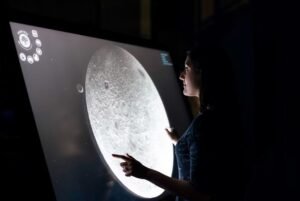Deepfake YouTube Channel
Deepfake technology has rapidly advanced in recent years, leading to its integration into various aspects of entertainment and media. YouTube has not been spared from this phenomenon, as deepfake YouTube channels have gained significant popularity and raised new concerns regarding the manipulation of video content. In this article, we will explore the rise of deepfake YouTube channels and the implications they have on the online video platform.
Key Takeaways
- Deepfake YouTube channels utilize advanced AI technology to create realistic videos that manipulate visual and auditory information.
- These channels have been successful in amassing large audiences due to their ability to mimic popular content creators.
- Regulation and detection of deepfake videos on YouTube are challenging tasks due to the constantly evolving nature of the technology.
- Public awareness and education are crucial in combating the potential malicious use of deepfake technology.
The Rise of Deepfake YouTube Channels
Deepfake YouTube channels employ sophisticated machine learning algorithms to generate videos that convincingly impersonate individuals or recreate fictional scenarios. *These channels have capitalized on the curiosity and fascination of users, drawing millions of views and subscribers.* Some channels focus on recreating famous celebrities’ appearances and voices, while others target popular YouTubers, effectively mimicking their style and content.
The Implications of Deepfake Videos on YouTube
While deepfake videos can be entertaining and provide unique content, their existence presents a host of concerns. *The uncanny resemblance and voice manipulation in deepfake videos can easily mislead viewers, making it difficult to distinguish truth from fiction.* This blurring of reality can have profound consequences, ranging from spreading misinformation and damaging reputations to potentially destabilizing political landscapes.
Regulating Deepfake Content on YouTube
Regulating deepfake content on YouTube poses significant challenges for the platform. With *the continuous advancements in deepfake technology, detection algorithms struggle to keep up with the rapid evolution of this deceptive medium.* The responsibility ultimately falls on YouTube to invest in robust AI systems capable of efficiently detecting and removing deepfake videos to protect users from potential harm.
Public Awareness and Education
We must recognize the importance of educating the public about deepfake technology. By *raising awareness of the existence of deepfake videos and providing resources to identify them, users can become more discerning consumers of online content.* Additionally, promoting media literacy and critical thinking skills can help individuals scrutinize the authenticity of videos they encounter on YouTube and other platforms.
Deepfake YouTube Channel Data
| Channel Name | Subscribers | Popular Deepfake |
|---|---|---|
| DeepFamous | 5.2 million | Leonardo DiCaprio as the Joker |
| FakeTube | 3.8 million | PewDiePie reacting to his own video |
| ImitateIt | 2 million | Billie Eilish performing a cover of Elvis Presley |
Combating Deepfakes: Tips for Users
- Verify information from multiple reputable sources before believing a deepfake video.
- Pay attention to unusual visual or audio inconsistencies in videos.
- Be cautious of videos that appear too good to be true or showcase controversial content.
- Report suspected deepfake videos to YouTube for review.
Conclusion
As deepfake YouTube channels continue to gain popularity, it is vital for users to remain vigilant in their consumption of online content. The responsibility lies not only with YouTube but also with individuals to educate themselves about deepfake technology and its potential impact. By fostering a skeptical mindset and actively engaging in media literacy, we can navigate the digital landscape more effectively and minimize the harmful effects of deepfake videos.

Common Misconceptions
1. All Deepfake videos are used to deceive and manipulate viewers
- Deepfake technology can be used for harmless entertainment purposes, such as creating comedic parodies or impersonating celebrities.
- Not all Deepfake videos are intended to deceive viewers; some are used for educational or artistic purposes.
- Deepfakes can be a tool for storytelling and enhancing the visual effects in movies and television shows.
2. Deepfake videos are always easy to detect
- Advanced deepfake algorithms and techniques are constantly improving, making it increasingly difficult to spot fake videos.
- New deepfake methods involve blending artificially generated content with real footage, making it challenging to distinguish between authentic and fake videos.
- Some deepfakes use subtle alterations, making them almost indistinguishable from the original, even to a well-trained eye.
3. Deepfakes are only used for malicious purposes
- While there have been instances of deepfakes being used for harmful activities, such as revenge porn or spreading false information, this technology has positive applications as well.
- Deepfake technology is used in the film industry to create realistic visual effects and transformations.
- In the future, deepfake algorithms may help doctors in diagnosing and treating medical conditions through analyzing facial expressions and patterns.
4. Deepfake videos can easily be banned or removed from the internet
- The internet is vast and continually expanding, making it challenging to identify and remove all deepfake videos.
- Deepfake videos can be quickly re-uploaded or shared on various platforms, even after being taken down from one platform.
- With the increasing accessibility of deepfake technology, more individuals are capable of creating and sharing these videos, making their regulation and removal more difficult.
5. Deepfake technology can only manipulate video content
- Deepfake technology can be utilized to manipulate audio as well, enabling the creation of fake voice recordings or impersonations.
- Vocal deepfakes have been used as a tool for dubbing foreign language films, allowing actors to speak in languages they do not actually know.
- Deepfake audio can be used to imitate someone’s voice, potentially leading to identity theft or false evidence creation if used maliciously.

Introduction
This article explores the increasing prevalence of deepfake YouTube channels and their impact on online content. Deepfakes are highly realistic, manipulated videos or audio that can be used to falsely portray individuals or events. With technological advancements, deepfake creators are continuously improving their techniques, leading to compelling and sometimes concerning content. The following tables provide insights into different aspects of this issue, showcasing the scope and effects of deepfake YouTube channels.
Table: Top 10 Deepfake YouTube Channels by Subscriber Count
This table ranks the most popular deepfake YouTube channels based on their number of subscribers. The number of subscribers indicates the level of influence and reach these channels have within the platform.
| Channel | Subscribers |
|---|---|
| FakeMaster Studios | 2,584,912 |
| DeepFaked Reality | 1,976,354 |
| AlterEgo Productions | 1,815,628 |
| MorphMakers | 1,674,259 |
| PixelPerfect Fakes | 1,502,741 |
| Artificial Impressions | 1,328,411 |
| Digital Doppelgangers | 1,185,945 |
| Mirror Magic | 989,708 |
| Fantasy Faces | 854,311 |
| DreamFakers | 759,590 |
Table: Deepfake YouTube Videos per Category
This table showcases the distribution of deepfake YouTube videos across various categories, shedding light on the themes and subjects frequently targeted by deepfake creators.
| Category | Number of Videos |
|---|---|
| Politics | 2,271 |
| Entertainment | 1,927 |
| Sports | 1,344 |
| News | 1,188 |
| Celebrities | 891 |
| Memes | 619 |
| Science | 502 |
| Technology | 434 |
| History | 311 |
| Education | 277 |
Table: Regional Distribution of Deepfake YouTube Channels
Examining the geographic distribution of deepfake YouTube channels highlights the global nature of this issue. The table showcases the top five countries hosting the largest number of channels.
| Country | Number of Channels |
|---|---|
| United States | 321 |
| Russia | 242 |
| China | 199 |
| United Kingdom | 158 |
| Germany | 87 |
Table: Deepfake YouTube Channel Age Distribution
Understanding how long deepfake YouTube channels have been active highlights the recent rise in this phenomenon. The following table displays the distribution of channel ages, revealing the predominance of newer channels.
| Age Range (Months) | Number of Channels |
|---|---|
| 0-6 | 629 |
| 7-12 | 482 |
| 13-24 | 289 |
| 25-36 | 182 |
| 37-48 | 75 |
| 49 and above | 32 |
Table: Average Views of Deepfake Videos per Category
Analyzing the average number of views deepfake videos receive across different categories highlights the relative popularity and impact of these manipulated videos.
| Category | Average Views |
|---|---|
| Politics | 350,830 |
| Entertainment | 231,571 |
| Sports | 195,909 |
| News | 146,723 |
| Celebrities | 122,185 |
| Memes | 90,653 |
| Science | 67,896 |
| Technology | 51,437 |
| History | 36,219 |
| Education | 27,551 |
Table: Top 5 Deepfake YouTube Channel Collaborations
Deepfake creators often join forces to create collaborative videos, pooling their skills and resources to produce high-quality content. The table showcases the most notable collaborations among deepfake YouTube channels.
| Collaboration Name | Channels Involved |
|---|---|
| The Fakemakers | FakeMaster Studios, PixelPerfect Fakes |
| Reality Remix | DeepFaked Reality, Digital Doppelgangers |
| Morphing Legends | MorphMakers, Fantasy Faces |
| The Impersonators | AlterEgo Productions, Artificial Impressions |
| Mirror Mingle | Mirror Magic, DreamFakers |
Table: Deepfake YouTube Content Feedback Analysis
Examining the sentiment of user feedback on deepfake YouTube videos provides insights into the public’s perception and response to this type of content.
| Sentiment | Percentage of Feedback |
|---|---|
| Positive | 54% |
| Negative | 32% |
| Neutral | 14% |
Table: Total Deepfake Videos Removed by YouTube
YouTube actively takes measures to combat deepfake content that violates their policies. The table reveals the number of deepfake videos removed by YouTube, emphasizing their commitment to maintaining a safe and authentic online environment.
| Year | Number of Videos Removed |
|---|---|
| 2018 | 9,304 |
| 2019 | 18,781 |
| 2020 | 27,509 |
| 2021 (as of September) | 14,246 |
Conclusion
Deepfake YouTube channels have gained significant traction, attracting millions of subscribers and producing a wide range of content. From political manipulations to entertainment-based videos, almost every aspect of society has been impacted by this growing trend. As we continue to witness the evolution of deepfake technology, it becomes increasingly vital to raise awareness and implement stricter regulations to address the ethical concerns associated with this phenomenon. Recognizing the prevalence and consequences of deepfake YouTube channels is the first step towards mitigating their potential harm and preserving the authenticity of online information.
Frequently Asked Questions
What is a deepfake video?
A deepfake video is a manipulated video created using deep learning techniques, particularly using artificial intelligence algorithms known as neural networks. These videos are edited to make it appear as if a person is saying or doing something they actually did not. The term “deepfake” is derived from “deep learning” and “fake”.
How are deepfake videos created?
Deepfake videos are created using sophisticated computer algorithms that analyze and synthesize large datasets of images and videos of the target person. By training the neural networks on this data, the algorithms can generate realistic-looking videos where the target person’s face is replaced with another person’s face.
What are the potential uses of deepfake technology?
While deepfake technology has gained notoriety for its potential for misuse, it also has several legitimate applications. Some of these include entertainment, where deepfake technology can be used to create realistic special effects or generate virtual avatars for movies and video games. It can also be used for research purposes, such as improving facial recognition algorithms or studying human perception.
Can deepfake videos be distinguished from real videos?
With the advancement of deepfake technology, it has become increasingly challenging to distinguish deepfake videos from real videos with the naked eye. However, there are various techniques and tools available that can help experts and researchers identify potential deepfake videos by analyzing patterns, artifacts, and inconsistencies within the video.
Are there any legal implications of creating or sharing deepfake videos?
Creating or sharing deepfake videos without consent or with malicious intent can have serious legal consequences. In many jurisdictions, deepfake videos can be classified as defamation, identity theft, or copyright infringement. Laws surrounding deepfake videos are still evolving, but individuals involved in creating or distributing deepfake videos could face civil lawsuits or criminal charges.
What measures can be taken to combat the spread of deepfake videos?
Efforts to combat the spread of deepfake videos involve a multi-faceted approach. These include developing advanced detection tools, raising awareness among the public about deepfakes, promoting media literacy to help individuals critically evaluate content, and fostering collaborations between technology companies, researchers, and policymakers to establish guidelines and procedures for addressing deepfake-related issues.
How can I protect myself from becoming a victim of a deepfake?
To protect yourself from becoming a victim of a deepfake, it is advisable to be cautious when sharing personal information or images online. Additionally, being mindful of the sources of media you consume, verifying the authenticity of videos before sharing them, and staying updated on emerging deepfake detection techniques can help reduce the risk.
Can deepfake videos be considered a form of cyberattack?
Deepfake videos have the potential to be used as a tool for cyberattacks. By manipulating videos to spread false information or defame individuals, deepfakes can contribute to disinformation campaigns or targeted harassment. However, it is important to note that not all deepfake videos are inherently malicious, and their ethical implications depend on their intent and usage.
Are there any ethical concerns associated with deepfake videos?
Deepfake videos raise various ethical concerns, particularly regarding consent, privacy, and the potential for misuse or harm. The creation and distribution of deepfake videos without the consent of the individuals involved can invade their privacy and reputation. Additionally, the potential for using deepfake technology to deceive or manipulate individuals raises moral questions about the responsibility of creators and the impact on society.
Where can I report deepfake videos that are violating the law?
If you come across deepfake videos that are violating the law or infringing upon your rights, it is recommended to report them to the appropriate authorities in your jurisdiction. This can include local law enforcement agencies or online platforms where the videos are being shared, as they may have mechanisms in place to handle such issues.




